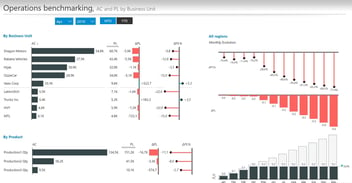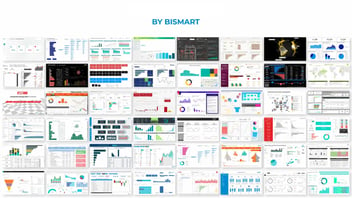What is a KPI, how can it help you optimize your business performance and how is it calculated? Access KPI examples and our downloadable guide.
KPIs have become an imperative for business activity. The vast majority of companies already base their strategic objectives, strategic plans and action plans on KPIs. However, implementing the wrong KPIs, misunderstanding the approach behind the indicators or not knowing how to use them can be counterproductive for businesses.

The relevance of KPIs in the business world began to proliferate with the discovery of the Balanced Scorecard (BSC) by Kaplan and Norton in the 1990s. The BSC marked a paradigm shift in the evaluation of business performance. Prior to its emergence, companies evaluated their performance from a purely financial perspective.
Balanced Scorecard (BSC)
The Balanced Scorecard (BSC) is a performance analysis tool that weighs business activity against business objectives and strategies and provides a picture of how the business will evolve over the long term. In the foreword to The Balanced Scorecard: Translating Strategy into Action, Kaplan and Norton explain the purpose of their model: "The Balanced Scorecard (BSC) translates an organization's mission and strategy into a comprehensive set of performance measures that provides the framework for a strategic measurement and management system. The Balanced Scorecard retains an emphasis on achieving financial objectives, but also includes the performance drivers of these financial objectives. [...] The BSC enables companies to track financial results while simultaneously monitoring progress in building the capabilities and acquiring the intangible assets they need for future growth."
Today there are many types of KPIs for any area of the business activity. However, the diversity of indicators is not always productive. In fact, as Kaplan and Norton suggested, using too many KPIs can lead to adverse results, since focusing on inappropriate KPIs generates noise that makes it difficult to understand the relevant information.
For all these reasons, it is essential for companies to start thinking about the performance indicators they use. Defining KPIs goes far beyond the selection of a few indicators. A KPI must be integrated into a company's strategic plan and action plan and be closely related to business objectives.
Bismart has produced a 'Guide to Evaluate Your Company's Performance and Strategic Plan' in which we explain everything you need to know about the BSC, KPIs, strategic objectives, action plans and performance indicators. You can download it below:
What is a KPI?
A KPI (Key Performance Indicator) is a measure used to gauge the performance of business activity. It arises from data analysis and is related to the defined business objectives and strategies, insofar as it is used to calculate the degree of performance of the established objectives and to compare the current situation with the desired one.
Contrary to what it may seem, a KPI is not a metric, although it is common for some KPIs —especially those in finance— to be metrics. Metrics are simply units of measurement, whereas KPIs are indicators of value that aim to improve business activity and strategies. Therefore, while KPIs can be metrics, any metric is not a KPI. To be a KPI, the metric must contribute to informed decision making.
It is worth noting that, in the evaluation and analysis of their performance, companies usually use multiple performance indicators, and each department or business unit define and uses the ones they consider appropriate according to the particularities of their business area. Of all the performance indicators defined, each organization will determine which ones provide the most value when weighing the achievement of their objectives. The indicators considered decisive are indeed key performance indicators or KPIs.
KPIs are applicable and useful to measure almost any aspect of business activity, but it is essential not to get carried away. We should only select those KPIs that will provide knowledge and value and help us to improve performance, make better decisions and plan better actions and strategies. Pearl Zhu, Corporate Global Executive with more than 22 years of experience in strategic planning and information technology, notes: “Selecting the right measure and measuring things right are both art and science. And KPIs influence management behavior as well as business culture.”
KPIs: Examples and types of KPIs and performance indicators
As already mentioned, there are a large number of KPIs and each one weighs a specific aspect of the business activity. The KPIs most commonly used in sales have nothing to do with those applied by the finance department. In fact, financial KPIs are the most distinctive, rigid and easy to interpret. In other business areas the application of KPIs and their subsequent interpretation may vary depending on the approach. This is precisely why it is so important to establish common and shared perceptions throughout the company on how to calculate and analyze KPIs.
Performance indicators can be operational, tactical or strategic:
- Operational indicators: Linked to the company's operations. They measure the efficiency of the company's daily operations and activities in relation to the operational efficiency parameters established by the company. They are measured in the short term.
- Tactical indicators: They track business requirements, problems and opportunities for improvement with the aim of controlling the processes established to improve business performance. They are usually short-medium term.
- Strategic indicators: They gauge the fulfillment of the defined strategic objectives and, therefore, are usually long term.
Another way of classifying the types of performance indicators is according to whether they are of benefit, cost or accuracy.
- Benefit: They measure the benefit contribution of an activity, action or business strategy. The higher the value of the indicator, the better.
- Cost: Measures the cost to the company of an activity, action or business strategy. The lower the value of the indicator, the better.
- Accuracy: Measures the accuracy with which an activity, action or business strategy has been carried out. For example, the level of incidents of a specific operation. In this case, the closer the result is to 0, the better.
To see examples of KPIs and how to calculate KPIs, download the 'Guide to Evaluate Your Company's Performance and Strategic Plan'.
KPIs in the age of data and technology
Technology has contributed to the dissemination and simplification of the use of KPIs. New technological tools facilitate the evaluation of business performance and the calculation of KPIs and other performance indicators. Data automation, computing systems, data warehousing, data analysis and data visualization tools such as Power BI simplify this task while producing much more reliable results. In this sense, business performance evaluation is linked to the data-driven culture of an organization. The more used companies are to working with data and performing good data practices, the more functional and reliable their KPIs will be. On the other hand, the way KPIs are calculated has also changed, with calculations now being virtually automatic thanks to the use of dashboards.
Do you want to optimize your dashboards? Read the post: '12 Tips You Can't Ignore When Creating a Dashboard'.
Likewise, the expansion and evolution of data and machine learning and their penetration into business spheres are transforming the role of KPIs. Data sets referenced in KPIs can now be used to forecast future performance trends through machine learning. Michael Schrage and David Kiron express, in the report Leading With Next-Generation Key Performance Indicators that machine learning is "poised to radically influence how executives use KPIs to monitor and spur growth."
KPIs and data-driven decisions
KPIs are essential to acquire a comprehensive understanding of the performance and state of the business and, consequently, to be able to make the right entrepreneurial decisions based on reliable data about the performance of our organization (data-driven decisions).
Basically, they are a source of knowledge that allows entrepreneurs to obtain a global vision of the business state, identify points for improvement, discover the most efficient strategies or actions, etc. In addition, KPIs can reveal good and bad practices or key elements of the business activity that were not being taken into account. The goal of KPIs is to drive change and improvement within the business ecosystem. If we do not analyze what we do it is impossible to know what we are doing right or wrong and, consequently, to transform our performance towards better actions.
In brief, performance indicators are an essential part of business performance analysis, as well as of the definition of business strategies and objectives. Virtually all companies already use performance indicators and KPIs. However, many companies select the KPIs they believe to be most convenient without taking into account the conception of the business strategy and activity that, in fact, should be the raw material of the indicators.



